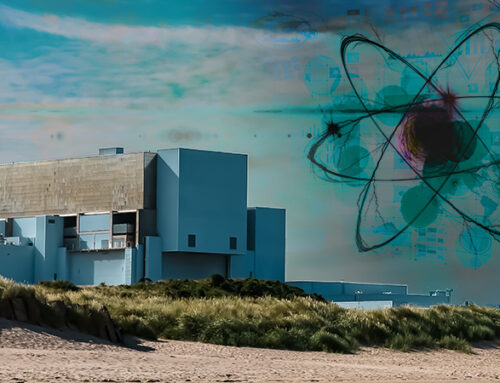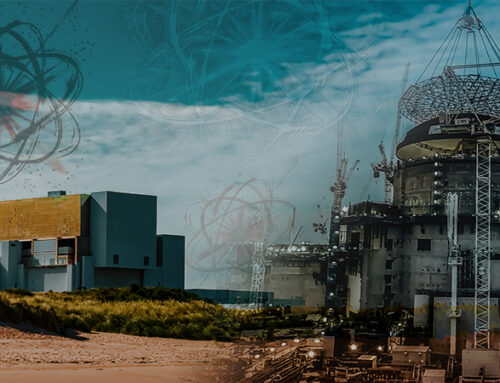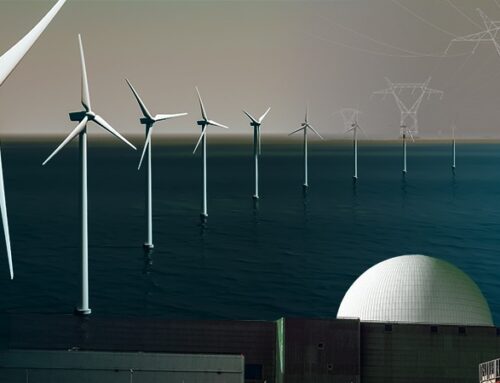Last month, Dutch research institute, NRG, re-ignited interest in thorium nuclear projects by announcing a new investigation into the use of thorium reactors in collaboration with the EU. The Salt Irradiation Experiment (“Salient”), based at the High Flux Reactor in Petten, will begin with experiments to melt thorium fuel and then bombard it with neutrons to transmute the thorium into uranium-233, which can sustain the chain reaction needed to generate energy. If this is successful, the next step will be to study tough, temperature-resistant metal alloys and other materials that can survive the high heat and corrosive conditions inside a molten-salt reactor. Further investigations into handling of waste materials will follow.
“SALIENT is a way to build up experience with the use of fission fuel in the form of a molten salt. That hasn’t been done for decades and we’re also doing it to train ourselves,”
– Ralph Hania, lead scientist on the SALIENT project.
At the same time, the prototype Kalpakkam fast breeder reactor in India is expected to finally begin operations by the end of this year, after many delays.
Thorium has almost mythical status as a clean, safe nuclear technology which was edged out by the weapons potential of uranium-based nuclear power, but how realistic are these views, and is thorium technology likely to be a game-changer in the energy sector?
How nuclear reactors work
Nuclear reactors “burn” heavy elements in order to generate heat, which boils water to create steam which drives turbines to generate electricity. The generation process is similar to a coal-fired power station ie the turbines are driven by steam.

Traditional nuclear reactors consume uranium, of which there are a number of isotopes:
- uranium-238 (U-238), which makes up 99.27% of natural uranium ore but has relatively low fission potential;
- uranium-235 (U-235), which is just 0.72% of natural ore, but has high fission potential making it a key ingredient in weapons and reactor fuel;
- uranium-233 (U-233), which isn’t found in nature but is required in thorium molten-salt reactors, and also has a high fission potential.
The larger the number, the more neutrons are contained in the atomic nucleus, increasing the weight. Changing the number of neutrons can radically change the isotope’s stability (radioactivity) and the type of radiation it emits. The most common uranium isotopes are not very radioactive: U-238 has a half-life of 4.6 billion years, while U-235 has a half-life of 704 million years.

In a traditional nuclear reactor (known as a “light-water reactor”, or “LWR”), uranium forms the basis for nuclear fission. Naturally occurring uranium is primarily U-238, which is non-fissile, with about a 1% concentration of U-235, which is fissile. This natural uranium is enriched, by removing some of the U-238, to achieve a material with a 4% U-235 concentration.
Typically oxidised uranium is used due to its higher melting point. This material is combined with an organic binder and compacted to form pellets which are packed into metal fuel rods. The nuclear reactions within the rods emit large amounts of heat, which boil water to drive the steam turbines – after about 6 years a typical 2 metre fuel rod will no longer be hot enough to power the generators, and so must be replaced, however it is still very hot as only about 2% of the fuel is spent, and a significant amount of heat will still be produced in the fuel due to the beta decay of the fission products.
A variety of process take place within the rods. Some U-238 captures neutrons to form plutonium, while some uranium decays into thorium, which in turn decays into actinium, francium, radium, radon, polonium. Some of these waste materials can be recycled, but typically these processes are inefficient and expensive.
Thorium reactors
In contrast with the uranium-plutonium cycle described above, thorium reactors are fuelled with non-fissile thorium and a small amount of fissile uranium-235 which starts the fission chain reaction. As thorium reactors are breeder reactors, once they start running, there is no need to add more fissile material as it is generated within the reactor.

In a Liquid Fluoride Thorium Reactor (“LFTR”, pronounced “lifter”) the thorium is dissolved in molten fluoride salts, and the fuel is almost completely consumed by the fission process, meaning that there is no need for the re-fuelling cycle seen in conventional reactors. The majority of waste that is produced can be recycled into useful industrial products.

Thorium reactors are considered to be inherently safe as they cannot “melt down” in the way a conventional reactor can since the fuel is already molten. The molten salts are very stable and do not burn or boil away. Unlike LWRs, there is no part of the process that can go out of control leading to melting of the fuel rods and potential contamination and possible rapid vapourisation of the coolant, which would risk damaging the containment structures.
Freeze plugs are used at the bottom of the fuel tanks, which need to be actively cooled. If power is lost, or any other problem occurs, these plugs melt, allowing the molten fuel to drain into a series of underground tanks which are too small for the fuel to remain critical.
However, while the science is relatively straightforward, the engineering of thorium reactors is challenging, not least because of the corrosive nature of the molten salts which makes design of the containment structures problematic (although this challenge has been solved in other industries where molten salts are used). Molten salt is also a health hazard which can cause lung cancer or berylliosis, and the tritium produced in the reactors can cause birth defects.
There are also some proliferation concerns, and while it generally held that creating nuclear weapons from thorium would be difficult, the need to develop safeguards that demonstrate safety in this regard adds complexity to the design.
“No technology breakthroughs required [but] significant technical development and demonstration remains,”
– International Atomic Energy Agency, 2014.
Current estimates suggest that it may take until 2050 for a commercial thorium molten-salt breeder reactor to reach commercial operation, with prototypes costing billions of dollars to develop. Introduction of any new nuclear technology, including next generation LWRs, involves lengthy licensing processes, and the lack of a thorium-technology supply chain further deters potential investors.
Molten-salt reactors are not new
Molten salt reactors (“MSRs”) are an alternative to pressurised water reactors, and use molten fluoride salts as the primary coolant, at low pressure, operating at significantly higher temperatures than PWRs allowing for higher thermodynamic efficiency.
Interestingly, some of the early work on MSRs was undertaken by the US Air Force to explore the potential of molten-salt reactors as a basis for powering bombers. In 1954, a 2.5 MW prototype reactor was built, running on a small amount of U-235 dissolved in a molten salt of fluorine, sodium and zirconium. Although the project was eventually abandoned for cost reasons, the scheme formed the basis for further work on commercial molten salt reactors.
During the 1960s, an 8 MWt experimental molten salt breeder reactor, the Molten Salt Reactor Experiment (“MSRE”) was developed at the Oak Ridge National Laboratory in Tennessee and ran over four years to 1969.
Breeder reactors generate more fissile material than they consume – current commercial reactors derive about a third of their energy from fissile materials produced within the reactor itself. However the efficiency of breeder reactors would theoretically be higher, decreasing fuel needs by a factor of a hundred, and greatly reducing the amount of nuclear waste produced.
 In the first phase of MSRE, (1965-68), U-235 tetrafluoride (UF4) enriched to 33% was dissolved in molten lithium, beryllium and zirconium fluorides at 600-700°C which flowed through a graphite moderator at ambient pressure, with the fuel comprising about 1% of the fluid. The second phase of the project (1968-69) used U-233, making MSRE the first reactor to use U-233, though it was imported and not bred in the reactor. This program prepared the way for building a MSR breeder utilising thorium, which would operate in the thermal (slow) neutron spectrum.
In the first phase of MSRE, (1965-68), U-235 tetrafluoride (UF4) enriched to 33% was dissolved in molten lithium, beryllium and zirconium fluorides at 600-700°C which flowed through a graphite moderator at ambient pressure, with the fuel comprising about 1% of the fluid. The second phase of the project (1968-69) used U-233, making MSRE the first reactor to use U-233, though it was imported and not bred in the reactor. This program prepared the way for building a MSR breeder utilising thorium, which would operate in the thermal (slow) neutron spectrum.
“The R&D program demonstrated the feasibility of this system, albeit excluding online reprocessing, and highlighted some unique corrosion and safety issues that would need to be addressed if constructing a larger pilot MSR with fuel salt. Challenges would include processing facilities to remove the main fission products, though gaseous fission products come off readily in the gas purge system. It also showed that breeding required a different design, with a larger blanket loop and two fluids (heterogeneous). Tritium production was a problem,”
– World Nuclear Association.
In the UK, well-developed plans for a large, 2.5 GW lead-cooled fast spectrum MSR with the plutonium fuel dissolved in a molten chloride salt were only recently de-classified. Plutonium was chosen as the fuel due to the UK’s large plutonium stockpile. Theoretical work on the concept was conducted between 1964 and 1966, while experimental work was ongoing between 1968 and 1973. Funding for the project was withdrawn in 1974, partly due to the success of the Prototype Fast Reactor at Dounreay which was considered a priority as it went critical in the same year.
Germany also built thorium reactors in the 1980s – one at Hamm-Uentrop was helium cooled, while another at Kalkar used sodium as the coolant. The 300 MW Hamm-Uentrop reactor ran at full power for 423 days, but suffered from reliability problems and high costs. The 327 MW Kalkar plant was refused final permission for fuelling by the government on cost grounds, despite being fully constructed, and eventually the developer abandoned the project. The site was subsequently turned into an amusement park.
Thorium reactors under development
India working to exploit its major thorium reserves
India has world’s largest known thorium reserves, and is keen to exploit these in its power industry. As noted above, the 500MW Kalpakkan fast breeder reactor is shortly to begin operation, and is part of India’s three-stage thorium fuel plan:
- The first step involves building indigenously engineered pressurised heavy-water reactors and light-water reactors to produce plutonium – India recently announced it will build 10 700 MW PHWRs;
- The second stage will use fast-neutron reactors fuelled by plutonium to breed U-233 from thorium. This is the focus of a new project to develop a breeder reactor fuel processing plant at Kalpakkam.
- In the third stage, the country will use advanced heavy-water reactors for power generation, fuelled with U-233 obtained from the irradiation of thorium in PHWRs and fast reactors.
US leverages early Oak Ridge research
A number of US companies is exploring molten salt reactor technology, with some in collaboration with the US Department of Energy.
Massachusetts-based Transatomic Power Corp is planning to develop a single-fluid MSR with a zirconium hydride moderator and a lithium fluoride – uranium fluoride salt, which can hold about 27 times as much uranium as a LWR. They intend to develop a 550 MW plant over the next 5 years, at an estimated overnight cost of US$ 2 billion.
Newly incorporated Alpha-Tech Research Corp in Utah is developing a 30 MW thorium test reactor to produce medical isotopes, and has a consortium of 7 Utah counties considering supporting the project.
Flibe Energy based in Alabama, is studying a thorium-fuelled, graphite-moderated thermal reactor concept based on the 1970s MSRE. It uses lithium fluoride/beryllium fluoride (FLiBe) salt as its primary coolant in both circuits. A pilot plant is envisaged for 2019, with a 100 MW demonstration reactor entering operation in 2023, and ultimately a commercial plant in the 250-1000 MW range being ready by 2027.
Florida developer ThorCon International is developing small-modular reactors based on the MSRE concept and believes it can build a full-scale 250 MW prototype in as little as 4 years, providing a suitable test site can be found. The company is collaborating with the Indonesian government launching a molten salt thorium reactor that is expected to be operating by 2025.
The US is also collaborating with Chinese researchers on solid fuel MSR technology, which avoids some of the technical difficulties arising from the very high activity levels associated with the molten salts bearing dissolved fuels and wastes. The experience gained with component design, operation, and maintenance with clean salts is expected to make the design of liquid fuel processes easier.
China is also progressing its own thorium programmes
China is also a major developer of thorium reactors – in 2011 the Chinese Academy of Sciences announced its intention to commercialise a thorium-based MSR in 20 years (non-thorium MSRs and solid fuel thorium reactors are also being developed).
The Shanghai Institute of Applied Physics (SINAP) has two streams of thorium MSR development: solid fuel, in pebbles or prisms/blocks with a once-through fuel cycle, and liquid fuel (dissolved in FLiBe coolant) with reprocessing and recycle. A third stream of fast reactors to consume actinides from LWRs is planned.
- The solid fuel stream has only partial utilisation of thorium, relying on some breeding as with U-238, and needing fissile uranium input as well. SINAP aims at a 2 MW pilot plant initially, although this has recently been postponed, and a 100 MWt experimental pebble bed plant with open fuel cycle by about 2025, then a 1 GW demonstration plant.
- The liquid fuel stream claims full closed Th-U fuel cycle with breeding of U-233 and much better sustainability with thorium but greater technical difficulty. SINAP aims for a 2 MWt pilot plant by 2018, a 10 MWt experimental reactor by 2025 and a 100 MWt demonstration plant with full electrometallurgical reprocessing by 2035, followed by 1 a GW demonstration plant.
- A liquid fuel fast reactor optimised for burning minor actinides is to follow.
Other MSR and thorium projects
Canada’s Terrestrial Energy is developing a modular liquid-fuel MSR using low-enriched uranium. Each unit is envisaged to have a 190 MW capacity, and be deliverable in 4 years. A feasibility study is underway to explore siting the world’s first commercial unit at Canadian Nuclear Laboratories.
Thorium Power Canada claims to have a construction-ready, modular thorium reactor. A 10 MW plant is planned for Copiapa in Chile, while a 25 MW demonstration plant is slated for Indonesia.
UK-based Moltex Energy’s Stable Salt Reactor is a conceptual reactor design with no pumps that relies on convection from static vertical fuel tubes in the core to convey heat to the steam generators. The reactors are designed to be modular in construction, with unit sizes from 150 MW.
Japanese Thorium Tech Solutions plans to develop 10 MW mini thorium molten-salt power plants within five years for supplying IT servers and EV charging stations. A 200 MW plant is also planned over the same timeframe.
Seaborg Technologies in Denmark is also developing modular thorium MSRs, and is planning a 50 MWt pilot unit with a view to 250 MWt commercial modular units fuelled by spent LWR fuel and thorium.
A number of MSR projects is under development in Russia, including the Molten Salt Actinide Recycler and Transmuter (MOSART), developed by a consortium led but the Kurchatov Institute. MOSART is a fast reactor fuelled by spent LWT fuel without any uranium and thorium support.
Thor Energy is taking a different approach
Since 2013, Thor Energy has been operating a thorium test reactor in Halden, Norway, with the aim of demonstrating a thorium-based fuel that could be used instead of uranium in conventional reactors. By mixing thorium oxide with 10% plutonium, a self-sustaining nuclear reaction can be achieved. This fuel can be formed into the same type of fuel rods as used in conventional reactors, and would eliminate the need for the expensive uranium enrichment process, which poses a proliferation risk. It would also provide an effective means of re-cycling plutonium, which is currently stockpiled in a number of countries, including the UK.
This process, known as the thorium mixed oxide (or “thorium-MOX”), produces no new plutonium, and as the melting point of the fuel is much higher than conventional nuclear fuel, reactors would be significantly safer.
The struggle for next generation pressurised water reactors may provide an opening for thorium
Many observers claim that thorium lost out to uranium due to the preference for uranium-based reactors for military uses, however, the relationship between commercial nuclear power, and production of fissile materials for weapons is not as close as people think.
While there may be an element of truth in the military argument, the over-riding reason for the dominance of uranium is more likely to be the fact that development of any new nuclear technology (including next generation uranium reactors) runs into billions of dollars, and since uranium reactor supply chains are well understood and established, any competing fuel would have to provide very strong economic benefits in order to compete. To date, thorium-based reactors have not been economically viable.
“After six decades and the expenditure of the equivalent of tens of billions of dollars, the promise of breeder reactors remains largely unfulfilled and efforts to commercialise them have been steadily cut back in most countries,”
– International Panel on Fissile Materials.
However, as I have described before, next generation uranium reactors also face major engineering and economic challenges, so perhaps it is not surprising that the renewed interest in thorium comes at a time when uranium reactor technology appears to be stalling.







The industry is looking for any solution that starts with an empty sheet of regulatory paper. SMR, LFTR – whatever.
The majority of the cost of (new) nuclear energy is meeting unrealistic political regulations that have little or no real safety implications.
If building a radically different sort of reactor is what it takes, so let it be.
Even though conventional reactors are well developed and would be very cheap if the regulations were rewritten from scratch.
The over-regulation topic is a whole other question, and I’d expect new technologies to face the same challenges. I like the idea of thorium in principle because uranium reactors have low fuel efficiency which is wasteful in general and creates disposal issues.
If they can figure out a way of making LFTRs economic then I think this could be interesting (or if the true costs of waste management were incorporated into the cost of LWRs….)
Uranium reactors have low fuel efficiency because its not worth spending the extra capital on making them into breeders. Uranium is dirt cheap – the contribution of the raw fuel is less than 1% and the processed fuel rods only around 15% of the cost of producing electricity.
.
That cannot be a reason to go for thorium.
I will restate my conclusion: Thorium and other technologies like SMRs are not engineering solutions to engineering problems. They are – as is almost any energy today – engineering solutions to political problems. Namely ‘fear of nuclear’ which can be sidestepped by calling it a ‘new safer technology’.
It isn’t of course. It has its own set of dangers and problems that are every bit as severe as a traditional PWR, but they are problems that are as yet unregulated.
Uranium is cheap to mine etc, but its very expensive to dispose of since only a small amount is consumed in the reactor. Because the spent fuel remains radioactive for such a long time, I doubt the costs are being fully accounted for, so I think it’s likely that the comparative costs of the technologies aren’t considered on an even basis. I don’t have any data for that, it’s just my feeling.
Having less radioactive waste to deal with seems like a good reason to go for thorium, assuming the overall costs stack up, but otherwise I agree – the problems with next gen uranium reactors have nothing to do with the properties of uranium itself.